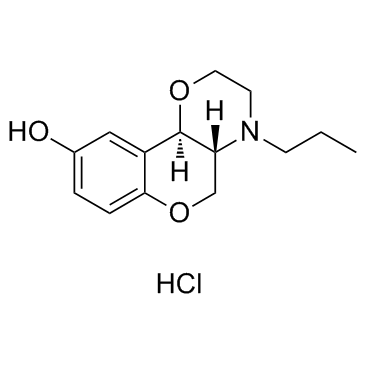(+)-PD 128,907 HCl

(+)-PD 128,907 HCl structure
|
Common Name | (+)-PD 128,907 HCl | ||
|---|---|---|---|---|
| CAS Number | 300576-59-4 | Molecular Weight | 285.76700 | |
| Density | N/A | Boiling Point | 389ºC at 760mmHg | |
| Molecular Formula | C14H20ClNO3 | Melting Point | N/A | |
| MSDS | USA | Flash Point | 189ºC | |
Use of (+)-PD 128,907 HCl(+)-PD 128907 hydrochloride is a selective dopamine D2/D3 receptor agonist, with Kis of 1.7, 0.84 nM for human and rat D3 receptors, 179, 770 n M for human and rat D3 receptors, respectively. |
| Name | (4aR,10bR)-4-propyl-3,4a,5,10b-tetrahydro-2H-chromeno[4,3-b][1,4]oxazin-9-ol, hydrochloride |
|---|---|
| Synonym | More Synonyms |
| Description | (+)-PD 128907 hydrochloride is a selective dopamine D2/D3 receptor agonist, with Kis of 1.7, 0.84 nM for human and rat D3 receptors, 179, 770 n M for human and rat D3 receptors, respectively. |
|---|---|
| Related Catalog | |
| Target |
Ki: 1.7 nM (human D3 receptor), 0.84 nM (rat D3 receptor), 179 nM (human D2 receptor), 770 nM (rat D2 receptor)[1][2]. |
| In Vitro | (+)-PD 128907 displaced [3H]spiperone binding from dopamine D3 receptors (Ki human=1.7 nM and rat=0.84 nM) with >100-fold and 900-fold selectivity over the human (Ki=179 nM) and rat (Ki=770 nM) dopamine D2 receptor[1][2]. |
| In Vivo | (+)-PD 128907 significantly decreases dialysate DA levels in D3 knock out mice. The IC25 values are 61 nM and 1327 nM, respectively, for wild type and D3knock out mice. The ratio of the IC25 values shows that (+)-PD 128907 is 22 times more potent in decreasing dialysate DA levels in wild type as compared to mice lacking the D3 receptor. The D3 agonist evokes a dose related decrease in dialysate DA in wild type mice. Post-hoc analysis shows that all doses tested (0.03, 0.1 and 0.3 mg/kg) significantly inhibit dialysate DA. The IC25 values are 0.05 and 0.44 mg/kg for wild type and knock out mice, respectively, indicating that systemically administered (+)-PD 128907 is 9 times more potent in decreasing dialysate DA in the ventral striatum of wild type as compared to D3 knock out mice. Doses of 1 mg/kg or higher of (+)-PD 128907 markedly inhibits dialysate DA in both wild type and D3 knock out mice[3]. |
| References |
| Boiling Point | 389ºC at 760mmHg |
|---|---|
| Molecular Formula | C14H20ClNO3 |
| Molecular Weight | 285.76700 |
| Flash Point | 189ºC |
| Exact Mass | 285.11300 |
| PSA | 41.93000 |
| LogP | 2.67640 |
| Personal Protective Equipment | Eyeshields;Gloves;type N95 (US);type P1 (EN143) respirator filter |
|---|---|
| RIDADR | NONH for all modes of transport |
|
Chemical genetics reveals a complex functional ground state of neural stem cells.
Nat. Chem. Biol. 3(5) , 268-273, (2007) The identification of self-renewing and multipotent neural stem cells (NSCs) in the mammalian brain holds promise for the treatment of neurological diseases and has yielded new insight into brain canc... |
|
|
Synthesis and dopamine agonist properties of (+-)-trans-3,4,4a,10b-tetrahydro-4-propyl-2H,5H-[1]benzopyrano [4,3-b]-1,4-oxazin-9-ol and its enantiomers.
J. Med. Chem. 33 , 445-450, (1990) The dopamine agonist profile of (+-)-trans-3,4,4a,10b-tetrahydro-4-propyl-2H,5H-[1]benzopyrano [4,3-b]-1,4-oxazin-9-ol (16a) and its enantiomers (16b-c) was examined. Racemic 16a exhibited moderate af... |
|
|
Assessment of cocaine-like discriminative stimulus effects of dopamine D3 receptor ligands. Acri, et al.
Eur. J. Pharmacol. 281 , (1995)
|
| (+)-PD128907 |
| (4aR,10bR)-rel-4-Propyl-2,3,4,4a,5,10b-hexahydrochromeno[4,3-b][1,4]oxazin-9-ol |